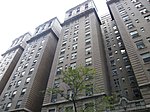Second Stage Theater
Broadway theatreOff-BroadwayTheatre companies in New York City

Second Stage Theater is a theater company founded in 1979 by Robyn Goodman and Carole Rothman and located in Manhattan, New York City. It produces both new plays and revivals of contemporary American plays by new playwrights and established writers. The company has two off-Broadway theaters, their main stage, the Tony Kiser Theater at 305 West 43rd Street on the corner of Eighth Avenue near the Theater District, and the McGinn/Cazale Theater at 2162 Broadway at 76th Street on the Upper West Side. In April 2015, the company bought the Helen Hayes Theater, a Broadway theater.
Excerpt from the Wikipedia article Second Stage Theater (License: CC BY-SA 3.0, Authors, Images).Second Stage Theater
West 43rd Street, New York Manhattan
Geographical coordinates (GPS) Address Nearby Places Show on map
Geographical coordinates (GPS)
| Latitude | Longitude |
|---|---|
| N 40.758194444444 ° | E -73.989638888889 ° |
Address
West 43rd Street 301
10036 New York, Manhattan
New York, United States
Open on Google Maps








